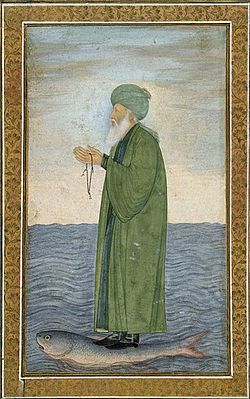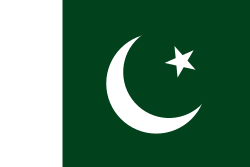Top Qs
Timeline
Chat
Perspective
Green in Islam
Significance of the colour green in Islam From Wikipedia, the free encyclopedia
Remove ads
The color green holds a distinct significance in Islamic culture, as it has appeared with symbolic meanings throughout various Islamic eras and among different schools and sects. It was present in the Qur’anic texts, especially in the descriptions of Paradise, as stated in the verse: "They will wear green garments of fine silk and brocade" (Qur’an 18:31). It is also mentioned in an authentic hadith that the Prophet Muhammad ﷺ wore two green garments, as narrated by Abu Rimthah: “He had locks hanging down as far as the lobes of the ears stained with henna, and he was wearing two green garments.” [1]
This article may incorporate text from a large language model. (October 2025) |

Remove ads
Quran
Summarize
Perspective

Verses from the Qur'an describing reclining on green cushions and garments of fine silk imbue the color with a sense of tranquility and peace. Believers are adorned with green garments of fine silk and heavy brocade, symbolizing purity and divine favor.[2][3]
Reclining on green Cushions and rich Carpets of beauty
In *Surah al-Raḥmān* (chapter 55), the color green is mentioned more than once. God refers to the color implicitly in verse 64, where He describes the two gardens as “mudhāmmatān.” Al-ʿAllāmah al-Ṭabāṭabāʾī interprets *mudhāmmatān* as “deeply green,” meaning a shade so dark and rich that it nearly approaches black.[5] In verse 76 of the same surah, he explains *rafraf khudr* as seating places covered with soft green silk fabric, symbolizing comfort and divine generosity.[6]
Upon them will be green garments of fine silk and heavy brocade, and they will be adorned with bracelets of silver; and their Lord will give to them to drink of a Water Pure and Holy.
Al-Khidr ("The Green One") is a Qur’anic figure who met and traveled with Moses.[9]
The present Green Dome over the Prophet’s tomb was added in 1818 under the Ottoman sultan Mahmud II.[10]
Remove ads
Islamic flags
Summarize
Perspective
Green flags were adopted by Shi'ites in the early Islamic period,[11] although the most common Shi'a color was white, in symbolic opposition to Abbasid black.[12][13] Thus in 817, when the Abbasid caliph al-Ma'mun adopted the Alid Ali al-Ridha as his heir-apparent, he also changed the dynastic color from black to green. The change was reverted al-Ma'mun had Ali killed, and returned to Baghdad in 819.[14][dubious – discuss]
Various national flags use green as a symbol of Islam, including Algeria, Azerbaijan, Comoros, Mauritania, Pakistan, Saudi Arabia, Sri Lanka, and Tajikistan.[15][16] Some Arab countries also use pan-Arab colors, which include green. These include: Iraq, Jordan, Kuwait, Lebanon, Sudan, Syria, and the United Arab Emirates, as well as several contested states including Palestine, Somaliland, and Western Sahara. Libya formerly also followed this principle, featuring green as its only component color (at the time the only flag in the world to use only one color) until 2011.
There are also several flags of Muslim-majority countries featuring green color that does not symbolize Islam. Examples include Bangladesh, Turkmenistan, Uzbekistan, Guinea, Guinea-Bissau, Mali, and Senegal (in the latter four cases, the green color is a component of the pan-African colors, which are also adopted by even Christian-majority countries such as Malawi and South Sudan).
In Islam, the color green holds significant symbolism and is often associated with nature, life, and renewal. It is frequently referenced in religious texts and traditions, symbolizing paradise and the lush landscapes described in the Qur'an. Beyond its use in national flags of some Islamic countries, such as Saudi Arabia and Iran, green is widely utilized in Islamic art, architecture, and attire. Its prevalence in mosques, Qur'anic manuscripts, and decorative elements underscores its importance in Islamic culture and aesthetics.[17][dubious – discuss]
Green is a common color used by Islamist political parties.[18]
Gallery
- A green Barbary corsairs flag with a skull on it.[19]
- Flag of Bangsamoro, Philippines
- Flag of the Kingdom of Egypt
- Flag of al-Qassam Brigades
Remove ads
See also
References
Sources
Bibliography
Wikiwand - on
Seamless Wikipedia browsing. On steroids.
Remove ads







